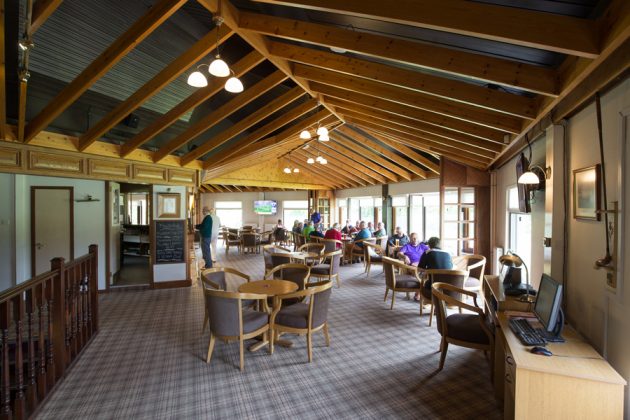Why More Golf Clubs Should Open Their Doors To The Public
Welcoming non-golfers in can generate revenue, attract new players and, most importantly, improve golf’s wider image.


When it comes to the future of golf, a similar message comes from each of the governing and administrative bodies within the game. To thrive and grow, our sport must be more inclusive and open, we must appeal to future generations and to more of those currently outside of golf.
With that objective in mind, it would seem a no-brainer for golf clubs to open their doors to the public. But many members’ clubs remain steadfast in saying that to set foot in their hallowed hallways, one must be either a member, a member’s guest or a green-fee-paying visitor (effectively a member for the day.)
There will likely always be historic, traditional golf clubs where this will remain the case. This is understandable. Some of the more famous clubs in this country, particularly those close to built-up areas, would be overrun if anyone passing was allowed in for a snoop around, to use the showers and nice soft towels before helping themselves to the free coffees and disappearing again.
But there are lesser known, perhaps less famous clubs that would benefit greatly from allowing non-golfing visitors to come in for a drink and a bite to eat, and it would be great for golf if they did.

A golf club lounge
One of the main barriers to getting into golf is cost – Cost of club membership is one of the biggest outlays in the sport, and it’s only going up. Many town or community golf clubs are fighting extremely hard to keep membership subscriptions down, and thereby affordable to the maximum number of possible members. One way to do this is to boost income via another source – By opening the bar and restaurant to the public maybe? Well yes, obviously!
OK, members might have to wait slightly longer for their bacon roll on occasion. But that’s a small price if membership subs can be limited. How many clubhouses are regularly overrun by those playing? Not many I can think of. There’s always capacity in the kitchens and at the bar for more custom, so why not try to grab some of it?
And won’t a few more people in the bar make things a bit more lively come a Friday evening or Sunday lunchtime? Surely, much better to be a golf club with a “great atmosphere” than one where the ambience is more akin to a dentist’s waiting room!
Get the Golf Monthly Newsletter
Subscribe to the Golf Monthly newsletter to stay up to date with all the latest tour news, equipment news, reviews, head-to-heads and buyer’s guides from our team of experienced experts.
We also want more people to play golf. What better way to snare a few new starters than by getting them through the front door of a club? Friendly staff and friendly members can tell non-golfing visitors about the benefits of playing and of socialising at the club. Hopefully good food and drink and the comfy surrounds will make them feel that it’s a place they could see themselves becoming a more established part of.
And then, of course, there’s golf’s image. Within the wider public it remains a sport that’s considered elitist, male-dominated and backward thinking. We golfers know this isn’t the case. But having buildings dedicated to golf (in towns and villages across this country, and around the world) that most people aren’t allowed into, doesn’t do much to help our cause!
If more clubs opened their doors to the, paying, public, there would less of a sense of snobbery surrounding golf clubs. It would be good PR and that could only be good for golf.
If the governing bodies want golf to be viewed as more inclusive and forward thinking, they need clubs to be more inclusive and forward thinking, as those clubs are where golf lives. If more were to open their doors to the non-golfing public and we could turn just 1% of the population into golf “fans” then it would be a win for the sport.

Fergus is Golf Monthly's resident expert on the history of the game and has written extensively on that subject. He has also worked with Golf Monthly to produce a podcast series. Called 18 Majors: The Golf History Show it offers new and in-depth perspectives on some of the most important moments in golf's long history. You can find all the details about it here.
He is a golf obsessive and 1-handicapper. Growing up in the North East of Scotland, golf runs through his veins and his passion for the sport was bolstered during his time at St Andrews university studying history. He went on to earn a post graduate diploma from the London School of Journalism. Fergus has worked for Golf Monthly since 2004 and has written two books on the game; "Great Golf Debates" together with Jezz Ellwood of Golf Monthly and the history section of "The Ultimate Golf Book" together with Neil Tappin , also of Golf Monthly.
Fergus once shanked a ball from just over Granny Clark's Wynd on the 18th of the Old Course that struck the St Andrews Golf Club and rebounded into the Valley of Sin, from where he saved par. Who says there's no golfing god?
-
 Right Now We Can All Experience The Most Premium Bags In Golf With Vessel's Anniversary Sale
Right Now We Can All Experience The Most Premium Bags In Golf With Vessel's Anniversary SalePremium golf brand Vessel is now offering an anniversary sale for a limited time only.
By Sam Tremlett
-
 Cleveland RTZ Wedge Review
Cleveland RTZ Wedge ReviewSam De’Ath uncovers the performance of the Cleveland RTZ Tour Satin wedge after conducting extensive testing on the golf course
By Sam De'Ath